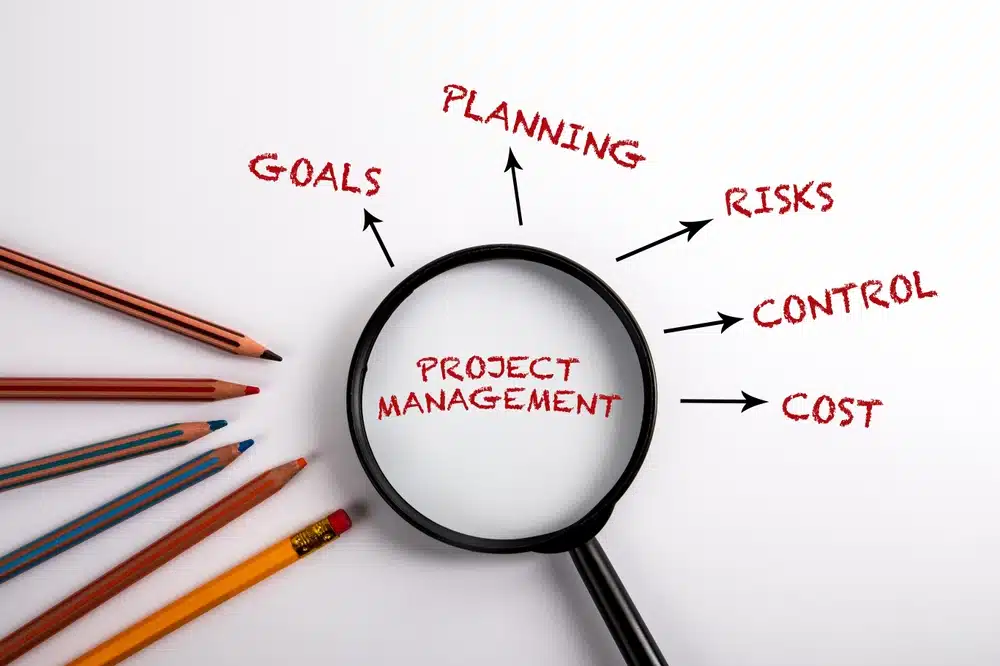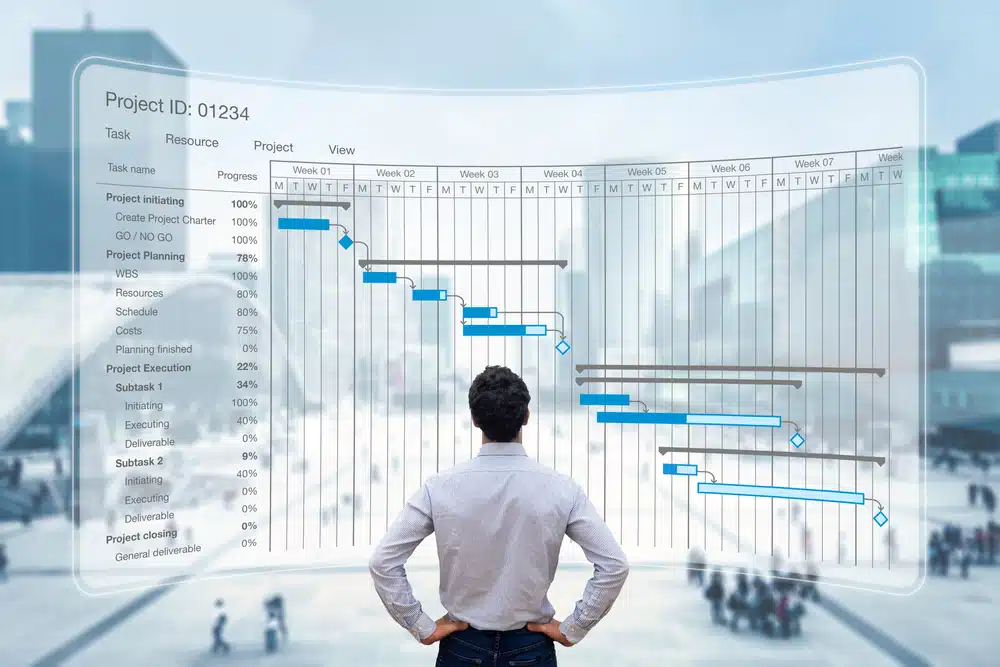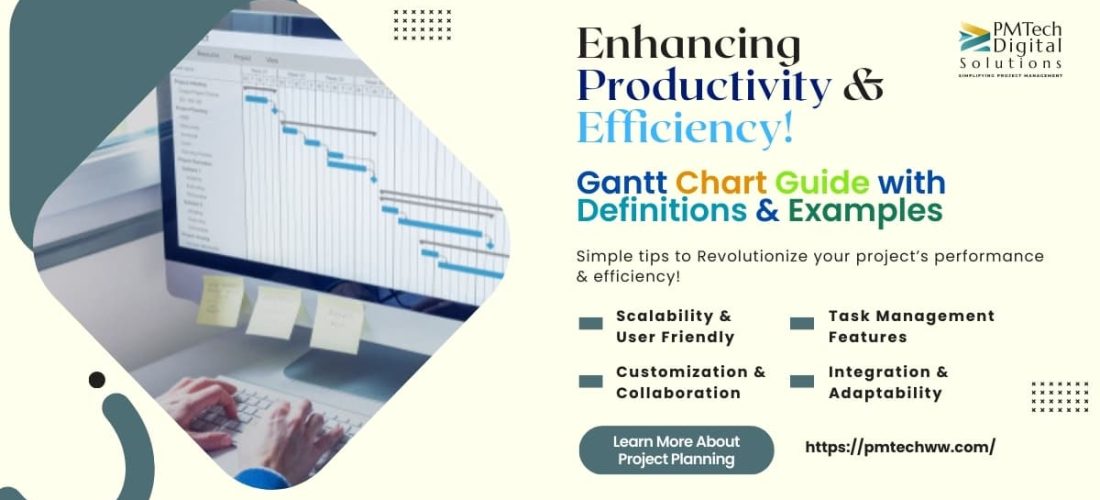Project planning is vital for successful project management. It sets the foundation for execution and outcomes. The Project Management Institute links effective planning to project success. A well-crafted plan serves as a roadmap for project completion.
During planning, the project manager develops a comprehensive plan. It covers requirements, goals, resources, and timelines. This plan keeps the project organized and aligned with expectations. It provides a complete view of the project lifecycle.
A good plan enables teams to collaborate effectively. It boosts productivity and helps navigate challenges. Teams can work together more smoothly with a clear plan in place.
Crafting a project plan involves several key components. These include defining scope, setting SMART goals, and identifying stakeholders. It also requires outlining deliverables and creating a detailed schedule.
Project managers break down deliverables into actionable tasks. They assign responsibilities and highlight dependencies. This ensures smooth progression and helps mitigate potential risks.
Effective planning keeps projects on track. It also enhances team motivation and engagement. Research shows motivated employees understand their work’s impact on company objectives. However, only 26% of employees have this clarity.
Key Takeaways:
- Project planning is crucial for successful project execution and outcomes.
- A comprehensive project plan serves as a roadmap, providing clarity and direction.
- Key components of a project plan include scope, goals, stakeholders, deliverables, and schedule.
- Effective project planning enhances team motivation, collaboration, and productivity.
- Breaking down deliverables into actionable tasks and highlighting dependencies ensures smooth project progression.
What is Project Planning?
Project planning lays the foundation for success in project management. It defines scope, sets goals, and identifies resources. This phase creates timelines, establishes budgets, and anticipates challenges. Thorough planning mitigates risks and ensures smooth execution.

Definition of Project Planning
Project planning determines steps, resources, and timelines for project completion. It breaks down projects into manageable tasks and assigns responsibilities. This process creates a roadmap for execution, aligning stakeholders and optimizing resources.
Stages of Project Management Lifecycle
The project management lifecycle comprises four main stages:
- Project Initiation: This stage defines purpose, scope, and objectives. It identifies stakeholders, assesses feasibility, and obtains approvals.
- Project Planning: Here, we develop a detailed plan with tasks, milestones, and timelines. We establish success metrics and create risk management strategies.
- Project Execution: We implement the plan, coordinating team efforts and monitoring progress. Regular communication keeps the project on track.
- Project Closure: We review deliverables, document lessons learned, and release resources. This stage includes celebrating achievements and formally closing the project.
Following these stages and dedicating time to planning sets the stage for success. It helps deliver projects that meet or exceed stakeholder expectations.
Effective project planning is the key to unlocking project success. It provides a clear roadmap, aligns stakeholders, and sets the stage for seamless project execution.
The Importance of Project Plans
Project plans are vital for success, guiding teams from start to finish. They ensure stakeholder alignment, accountability, and collaboration towards a common goal. Project planning lays the foundation for effective teamwork and increased visibility.
It’s crucial for visualizing the entire project lifecycle. Breaking down projects into manageable tasks helps develop clear strategies. Team members can better understand their roles and contributions to the bigger picture.

Visualizing the Project from Start to Finish
Project planning allows us to see the whole project journey. It breaks down tasks into smaller, manageable pieces. This visual representation helps team members grasp their roles and responsibilities.
Team members can see how their work fits into the overall project. This clarity improves understanding and motivation throughout the project’s lifecycle.
Keeping Stakeholders Aligned and Accountable
Project plans keep stakeholders aligned and accountable. They define objectives, timelines, and deliverables clearly. This ensures everyone works towards the same goals.
A well-crafted plan facilitates communication and transparency. It becomes easier to spot risks, make informed decisions, and adapt to changes. This alignment improves overall project outcomes.
| Benefits of Project Planning | Statistical Impact |
|---|---|
| Increased stakeholder satisfaction and collaboration | 94% of stakeholders report increased satisfaction when project objectives are clearly outlined |
| Improved project success rate | 65% of projects with meticulous planning have a higher success rate in meeting objectives |
| Cost savings through efficient resource allocation | 72% of organizations experience cost savings through comprehensive project planning |
| Reduction in delays and schedule overruns | 78% reduction in delays and overruns observed in projects that prioritize effective time management |
Enhancing Team Collaboration and Productivity
Effective planning fosters seamless teamwork. It defines roles clearly, helping members understand their contributions. This ownership boosts morale and productivity, leading to better outcomes.
86% of Project Managers believe that Project Planning is essential for successful Project execution.
A well-structured plan prevents team overload by mapping schedules and balancing workloads. It identifies potential bottlenecks and optimizes resource allocation. This support helps team members perform at their best.
Effective workload management increases job satisfaction and reduces turnover rates. Employees are more likely to stay with organizations that prioritize smart planning.
Key Components of a Project Plan
A comprehensive project plan is crucial for success. It guides teams through project stages and aligns everyone. Let’s explore the key components of a robust project plan.
Project Scope and Goals
A clear project scope forms the foundation. It outlines specific goals and objectives to achieve. Well-defined scope prevents scope creep and keeps the team focused.
It ensures desired outcomes are delivered within allocated resources and timelines. This helps maintain project boundaries and expectations.
Project Schedule and Milestones
The project schedule outlines task timelines and key milestones. Breaking down the project into manageable tasks helps effectively manage time and resources.
The schedule should account for task dependencies. It should include contingency time for unexpected delays or challenges.

Resource Allocation and Budget
Effective resource allocation is vital for project success. Identify required resources, including team members, equipment, materials, and budget. Careful allocation and monitoring optimize efficiency and budget control.
| Resource Type | Allocation Considerations |
|---|---|
| Human Resources | Assign tasks based on skills, experience, and availability |
| Equipment and Materials | Ensure timely procurement and availability of necessary resources |
| Budget | Allocate funds strategically to cover project expenses and contingencies |
Risk Management Strategy
Every project has risks. A risk management strategy is crucial. Identify potential risks early and develop contingency plans and mitigation strategies.
Regular risk assessments throughout the project lifecycle help maintain proactivity. They allow teams to adapt their approach as needed.
According to recent studies, projects that adhere to a well-defined project plan are 25% more likely to meet their set milestones and timelines, and teams that follow a predetermined project plan are 30% more likely to achieve project success compared to those without a clear plan.
These key components create a solid foundation for successful project execution. A comprehensive plan guides the team and aligns all stakeholders.
It serves as a powerful communication tool. This ensures everyone works towards a common goal effectively.
Steps to Create a Project Plan
A comprehensive project plan is crucial for successful project execution. Following a structured approach ensures all critical aspects are covered. Your team will be well-prepared to tackle challenges ahead.

- Define project goals and objectives
- Identify project deliverables and milestones
- Break down deliverables into tasks
- Determine task dependencies and sequence
- Estimate task durations and resource requirements
- Create a project timeline and schedule
- Assign roles and responsibilities
- Develop a communication plan
- Identify and assess potential risks
- Establish a budget and resource allocation plan
- Review and finalize the project plan
- Continuously monitor and adjust the plan as needed
These steps create a solid foundation for your project. They ensure stakeholder alignment and provide a clear roadmap for the team. Thorough, realistic, and adaptable planning is key to project success.
According to the Project Management Institute’s 2020 Pulse of the Profession report, 11.4% of business investment is wasted due to poor project performance. Effective project planning is crucial for minimizing risks, improving efficiency, and ensuring alignment among team members.
Jacques Alexis, an assistant teaching professor at Northeastern University, emphasizes planning’s critical role in project management. He stresses the importance of engaging stakeholders throughout the plan creation process.
Early stakeholder involvement yields valuable insights. It helps set realistic expectations and builds a shared vision for project success.
| Project Plan Component | Description |
|---|---|
| Project Overview | Provides a high-level summary of the project, including its purpose, objectives, and key stakeholders. |
| Scope Statement | Defines the boundaries of the project, specifying what is included and excluded from the project scope. |
| Work Breakdown Structure (WBS) | Breaks down the project deliverables into smaller, manageable tasks and subtasks. |
| Project Schedule | Outlines the timeline for completing project tasks, milestones, and deliverables. |
| Resource Allocation Plan | Identifies the resources (human, financial, and material) required to complete the project and how they will be allocated. |
| Risk Management Plan | Identifies potential risks, assesses their impact, and outlines strategies for mitigating or responding to them. |
| Communication Plan | Defines how project information will be shared among stakeholders, including the frequency, format, and channels of communication. |
Incorporating these essential components into your project plan ensures thorough consideration of all aspects. Your team will be well-equipped to deliver successful results.
Defining Project Scope and Success Metrics
Defining project scope is vital for success. It protects against scope creep and keeps the project on track. Let’s explore key elements of scope definition and success metrics.

Crafting a Project Purpose Statement
A project purpose statement captures the project’s essence. It answers critical questions about goals, stakeholders, importance, methods, and timeline. This brief ensures team alignment and focus on shared objectives.
- What are we trying to achieve?
- Who are the key stakeholders involved?
- Why is this project important?
- How will we accomplish our goals?
- When do we expect to complete the project?
Establishing Performance Criteria and Quality Standards
Success metrics help track progress and identify areas for improvement. They determine if we’ve achieved our goals. Key metrics include Gross Profit Margin, Customer Satisfaction Score, and Schedule Variance.
Cost Variance and Resource Utilization are also crucial. These metrics guide data-driven decisions and project adjustments. Regular monitoring ensures we stay on course and deliver desired results.
| Metric | Description | Formula |
|---|---|---|
| Gross Profit Margin (GPM) | Measures the team’s contribution to overall profit | (Gross profit / revenue) x 100 |
| Customer Satisfaction Score | Measures client satisfaction with the project deliverables | (Total point score from survey / Number of questions) x 100 |
| Schedule Variance | Indicates whether the project is ahead or behind schedule | Work scheduled to date – Work actually completed to date |
| Cost Variance | Determines if the project is on track financially | Planned budget – Actual costs |
| Resource Utilization | Measures the effectiveness of human resources | (Staff hours clocked for project / Total staff hours assigned) x 100 |
Defining project scope and success metrics is not a one-time exercise. As the project progresses, we may need to revisit and refine these elements based on stakeholder feedback and changing circumstances.
Investing time in scope definition and success metrics sets projects up for success. It ensures value delivery to stakeholders. Regular refinement based on feedback keeps the project aligned with changing needs.
Identifying Key Project Stakeholders

Identifying and engaging key project stakeholders is crucial for effective project planning. These individuals shape the project’s trajectory from start to finish. Project managers must prioritize stakeholders based on their power, interest, and potential impact.
Stakeholders fall into two main categories: internal and external. Internal stakeholders include team members and executives within the organization. External stakeholders comprise customers, users, suppliers, and investors. Understanding each group’s expectations and influence is vital for successful project management.
Clarifying Roles and Responsibilities
After identifying key stakeholders, it’s essential to clarify their roles and responsibilities. This ensures everyone understands their part in the project and can contribute effectively. Tools like Confluence can facilitate virtual collaboration sessions to define and document these roles.
Clear roles and responsibilities offer several benefits. They ensure accountability and ownership among team members. They help identify skill gaps and allocate resources accordingly. They also streamline communication and decision-making processes.
- Ensure accountability and ownership among team members
- Identify skill gaps and allocate resources accordingly
- Streamline communication and decision-making processes
- Avoid duplication of efforts and minimize conflicts
Ensuring Cross-Functional Collaboration
Cross-functional collaboration is often necessary for successful project planning and execution. Project managers must foster an environment that encourages teamwork and open communication across different departments. This approach promotes knowledge sharing and enhances overall project outcomes.
To promote cross-functional collaboration, several strategies can be employed. Regular meetings and status updates with stakeholders are essential. Using collaboration tools helps share project documents and timelines effectively. Encouraging open dialogue and seeking feedback from stakeholders is crucial.
- Schedule regular meetings and status updates with stakeholders
- Use collaboration tools to share project documents, timelines, and deliverables
- Encourage open dialogue and actively seek feedback from stakeholders
- Celebrate milestones and successes to boost team morale and engagement
Effective stakeholder engagement is both an art and a science. It requires a deep understanding of stakeholder needs, expectations, and communication preferences, as well as the ability to adapt and respond to changing project dynamics.
Identifying key stakeholders, clarifying roles, and ensuring collaboration builds a strong foundation for successful projects. Early investment in stakeholder engagement yields significant benefits. These include improved project outcomes, increased team satisfaction, and stronger long-term relationships.
Outlining Project Deliverables
Project deliverables are tangible outcomes created during a project. They must be within scope, agreed upon by stakeholders, and contribute to objectives. Deliverables vary in size and complexity, from stadiums to marketing documents.
Deliverables can be external (client-oriented) or internal (organizational). External deliverables include business case documents, status reports, and final products. Internal deliverables comprise team meetings, project plans, and lessons learned documents.
Process deliverables facilitate project progression without directly delivering requirements. Examples include scope change processes, team meetings, and resource management plans. Product deliverables directly fulfill project requirements, forming part of the final product or service.
Well-defined deliverables help reduce scope creep, minimize delays, and align team efforts towards project success.
Project milestones are checkpoints marking important activities and tracking progress. They comprise smaller, tangible tasks that teams produce. Signposts guide teams on a day-to-day or weekly basis.
To outline project deliverables effectively, follow these steps:
- Create a list of deliverables that will help achieve the greater vision of the project.
- Clearly outline the project’s concrete and tangible deliverables or outcomes.
- Centralize these deliverables in a project management tool with designated cards for each one to keep work moving forward.

Tracking project deliverables offers numerous benefits, including:
- Efficient project scheduling
- Optimized resource management
- Improved team alignment
- Meeting stakeholder expectations
- Accurate risk projection and estimates
| Deliverable Type | Examples |
|---|---|
| Process Deliverables | Scope change process, team meetings, lessons learned sessions, resource management plan |
| Product Deliverables | Web application feature, house foundations, customer documentation, architectural design |
| External Deliverables | Business case documents, project status reports, final product or service |
| Internal Deliverables | Project plans, sprint backlogs, lessons learned documents |
Proper management of project deliverables leads to accurate estimates and optimized resources. It also aligns teams, meets stakeholder expectations, and mitigates risks. Research shows 37% of projects fail due to poorly defined objectives and milestones.
Breaking Down Deliverables into Actionable Tasks
Breaking down key deliverables into smaller, manageable tasks is crucial for project success. This process ensures efficient project execution and team alignment. By creating actionable tasks, we provide clarity and direction for each team member, boosting productivity and collaboration.
Consider various types of project deliverables when breaking them down. These include internal and external processes, as well as internal and external products. Creative teams may focus on tasks like blog posts and website wireframes. Product teams might prioritize roadmaps, UI wireframes, and customer retention reports.
Identifying Task Dependencies
Recognizing dependencies between tasks is vital when breaking down deliverables. Task dependencies occur when one task relies on another’s completion. Highlighting these relationships allows for better planning and prioritization, ensuring a smooth workflow.
Examples of task dependencies include:
- A website wireframe must be approved before the design team can begin creating the final graphics.
- Market research must be conducted before the marketing team can develop a targeted campaign strategy.
- The foundation of a house must be laid before the walls can be constructed.
Prioritizing and Assigning Tasks
After breaking down deliverables and identifying dependencies, prioritize and assign tasks to team members. Effective prioritization ensures focus on critical and time-sensitive tasks. Consider each team member’s workload and skills when assigning responsibilities.
Key factors for task prioritization include:
| Factor | Description |
|---|---|
| Urgency | How soon does the task need to be completed? |
| Importance | How critical is the task to the overall success of the project? |
| Dependencies | Does the task rely on the completion of other tasks? |
| Skillset | Which team member has the necessary skills to complete the task efficiently? |
By breaking down our deliverables into actionable tasks, identifying dependencies, and prioritizing and assigning tasks effectively, we can create a clear and organized project plan that sets our team up for success.

Effective task management requires open communication and regular progress reviews. Stay agile and responsive to ensure project success. Adapt as needed to keep your project on track and deliver desired results.
Developing a Project Timeline
A well-crafted project timeline is essential for successful project management. It visually represents the project’s schedule, task sequences, and durations. This tool helps managers handle workloads and adapt to changing needs effectively. It includes task dependencies, resource allocation, and milestones.
The timeline guides the entire project team dynamically. Creating it starts with defining the project scope and objectives. The project brief aligns all stakeholders with common goals. Tasks should be displayed chronologically for comprehensiveness and flexibility.
Estimating Task Durations
Estimating task durations is crucial for building a project timeline. This process involves breaking down the project into smaller, manageable tasks. Assessing time for each task helps identify potential bottlenecks and allocate resources effectively.
Project managers should work closely with team members to estimate accurately. They can leverage their expertise and experience. The three-point estimation technique considers best-case, most likely, and worst-case scenarios. This method provides realistic estimates and accounts for potential risks.
Creating a Gantt Chart
A Gantt chart visually represents project timelines, showing task relationships, durations, and dependencies. It helps track progress, identify critical paths, and make informed decisions. Project managers can keep projects on schedule using this tool.
When creating a Gantt chart, it’s essential to:
- List all project tasks
- Determine task dependencies
- Estimate task durations
- Assign resources to each task
- Plot tasks on the timeline
Following these steps creates a comprehensive, visually appealing Gantt chart. It effectively communicates the project timeline to all stakeholders. This tool enhances project management and team coordination. For further details, please read our comprehensive guide on Gantt Chart with Definitions & Examples.
Building in Contingency Time
Unforeseen circumstances can arise in any project. Building contingency time into the timeline mitigates potential delays or setbacks. This buffer allows flexibility and helps keep the project on track.
Contingency time should be carefully considered and allocated based on the complexity and risk level of each task. As a general rule, it’s recommended to add a 10-20% buffer to the estimated duration of each task.
Incorporating contingency time creates a more resilient and adaptable plan. This approach increases the likelihood of project success. It helps managers handle unexpected challenges more effectively.
A comprehensive project timeline is crucial for effective project planning. Estimating task durations, creating Gantt charts, and including contingency time are key steps. These elements establish a clear path and maintain the big picture.
A well-crafted timeline keeps everyone informed and prevents bottlenecks. It makes adapting to change easier and paves the way for project success. Effective timelines are essential tools for project managers and teams.
Allocating Resources and Creating a Budget
Resource allocation and project budgeting are vital for successful project management. They ensure timely completion, budget adherence, and quality standards. Proper allocation streamlines workflows, reduces delays, and boosts efficiency by aligning project phases with specific requirements.
Planning resource usage helps identify potential bottlenecks before they impact timelines. This foresight enhances client satisfaction. A well-crafted allocation strategy optimizes resources, increasing the likelihood of meeting project objectives.
Merging dashboards with automation enhances project management efficiency by providing visual, intuitive overviews of resource distribution and streamlining tracking and allocation processes.
Consider these best practices when allocating resources and creating a project budget:
- Allocate resources during the project planning phase for an effective resource allocation strategy.
- Ensure project objectives are specific, time-bound, and attainable to guide resource allocation decisions.
- Understand available resources, including team capacity, budgets, tools, and required skills before allocating resources.
- Maintain a clear project scope to avoid scope creep and guide resource allocation decisions.
- Monitor project progress in real-time to allow for adjustments in resource allocation if unexpected changes occur.
Project budgeting involves estimating and allocating funds for project completion. It considers costs like labor, materials, equipment, software, overhead, and contingency. Successful budgeting aligns goals with broader business objectives and demonstrates strategic thinking.
| Resource Allocation | Project Budgeting |
|---|---|
| Assigning human and non-human resources (staff, contractors, facilities, tools, technology) to the project | Estimating and allocating funds for project completion within scope, time, and quality requirements |
| Balancing demand and supply, optimizing utilization, and managing dependencies, conflicts, and risks | Considering costs such as labor, materials, equipment, software, overhead, and contingency |
Risk-driven prioritization is crucial in project management. It involves allocating more resources to high-risk areas to ensure project success. Efficient allocation includes mentoring, optimizing resources, and avoiding overconsumption in critical areas.

In interviews, show knowledge of principles, methods, and tools for project budgeting and resource allocation. Provide examples of your experience in planning and managing project resources. Highlight your ability to adapt to different scenarios and optimize resource allocation.
What Is the Purpose of a Project Management Plan?
A project management plan guides teams through the project lifecycle. It outlines scope, objectives, timeline, budget, and resources for successful delivery. This plan provides a framework for execution, aligning stakeholders towards common goals.
A well-structured plan communicates vision, manages expectations, and fosters collaboration. It identifies risks, allocates resources efficiently, and monitors progress against milestones. This crucial tool ensures timely, on-budget delivery that satisfies all stakeholders.
The Elements of A Project Plan
A typical project plan includes several key components. These project management plan elements work together to provide a holistic view of the project.
- Project scope and objectives
- Project schedule and milestones
- Resource allocation and budget
- Risk management strategy
- Quality management plan
- Communication plan
- Change management plan
Each element plays a crucial role in project success. Defining scope prevents creep and maintains alignment with objectives. The schedule outlines the timeline, while budget allocation ensures necessary resources are available.
Techniques for the Project Planning Process
Project planning involves steps and techniques for creating an effective plan. These include brainstorming, mind mapping, Work Breakdown Structure (WBS), Gantt charts, and PERT.
- Brainstorming and mind mapping to generate ideas and identify project requirements
- Work Breakdown Structure (WBS) to break down the project into manageable tasks and deliverables
- Gantt charts to visualize the project timeline and dependencies
- PERT (Program Evaluation and Review Technique) to estimate task durations and identify the critical path
- Risk assessment and mitigation planning to identify and manage potential project risks
These techniques ensure thorough, realistic, and achievable plans. Regular reviews and updates maintain relevance throughout the project lifecycle.
How Long Does the Project Planning Phase Take?
Project planning duration varies based on complexity and size. On average, it takes 8-10% of total project time. Investing sufficient time in planning sets projects up for success.
Rushing through planning can lead to unrealistic expectations, missed deadlines, and budget overruns. Thorough planning is crucial for project success.

How To Make a Project Plan When You Don’t Have All the Answers
Creating a plan without all information requires informed assumptions and flexibility. Identify and document assumptions made during planning. Build contingency time and budget into the plan for uncertainties.
Regularly review and update the plan as new information becomes available. Communicate assumptions and limitations to stakeholders. This flexible approach helps navigate uncertainties and adapt for success.
How To Manage Your Project Plan
Effective plan management keeps projects on track. Key strategies include regular reviews, progress tracking, open communication, and change management.
| Strategy | Description |
|---|---|
| Regular reviews and updates | Regularly review and update the project plan to reflect changes in scope, timeline, or resources. This helps maintain the plan’s relevance and accuracy throughout the project lifecycle. |
| Progress tracking | Monitor project progress against the plan using tools like Gantt charts, burndown charts, or project dashboards. This helps identify deviations from the plan and enables timely corrective actions. |
| Communication and collaboration | Foster open communication and collaboration among team members and stakeholders. Regularly share updates on project progress, risks, and issues to ensure everyone is aligned and informed. |
| Change management | Establish a formal change management process to evaluate, approve, and implement changes to the project plan. This helps maintain control over the project scope and prevents unauthorized changes from derailing the project. |
Implementing these strategies ensures effective plan management and project success. Investing in comprehensive planning and diligent management is essential for delivering value-driven projects.
Conclusion
Effective project planning is crucial for successful delivery. A comprehensive plan sets the stage for triumph. It clarifies goals, scope, timeline, resources, and risks. This enables confident navigation through the project management lifecycle.
Our plan serves as a roadmap through each project stage. Clear objectives and efficient resource allocation minimize scope creep. Gantt charts can boost on-time delivery by 15%. A thorough risk strategy contributes to 90% of successful projects.
At PMtech Digital Solutions, we use advanced tools to optimize portfolio management. We align projects with strategic business goals. This approach enhances overall project success rates.
Effective communication and collaboration are vital for project execution. Clearly defined roles improve team accountability by 65%. Our plan ensures everyone understands their responsibilities. We foster cross-functional teamwork and regularly review stakeholder feedback.
A project plan should be flexible and adaptable. By embracing change and continuous improvement, we overcome challenges. This approach drives successful project outcomes and exceeds expectations.
In summary, effective planning is the foundation of project success. Dedication to comprehensive plans and best practices yields results. With the right approach, we transform ideas into reality and deliver meaningful outcomes.
Frequently Asked Questions
Why is project planning important?
Project planning is vital for visualizing the entire project. It helps develop clear strategies to achieve goals. The process guides stakeholders and keeps team members accountable. It also boosts collaboration and productivity.
What are the key components of a project plan?
A comprehensive project plan includes several key elements. These are the project scope and goals, schedule and milestones. It also covers resource allocation, budget, and risk management strategy.
How do we define project scope and success metrics?
To define scope and metrics, we create a project purpose statement. This outlines the what, who, why, how, and when. We also set performance criteria and quality standards to measure success.
How do we identify key project stakeholders?
Identifying stakeholders involves listing those impacted by the project. We clarify their roles and responsibilities. Ensuring cross-functional collaboration throughout the project lifecycle is crucial.
How do we allocate resources and create a budget?
We define goals and stakeholders to allocate resources. Departments may split project costs. We set spending limits per goal metric. All roles and stakeholders are outlined in project documentation.
How long does the project planning phase typically take?
Project planning usually takes 8-10% of the total project time. The exact duration varies based on complexity, size, and resource availability. Larger projects may require more planning time.
How do we manage the project plan when faced with unknowns?
Keep the plan flexible to handle inevitable changes. Regular reviews and updates are essential. Communicate changes to stakeholders promptly. This approach helps adapt the plan as needed.
What tools can we use for project planning?
Several tools aid project planning. Gantt charts create timelines, while Trello boards centralize deliverables. Confluence manages tasks and collaboration. Jira tracks tasks across teams and provides workflow insights.


















170 Responses
Can you be more specific about the content of your article? After reading it, I still have some doubts. Hope you can help me.
Thanks for sharing. I read many of your blog posts, cool, your blog is very good. https://accounts.binance.com/en/register-person?ref=JHQQKNKN
I am glad to be a visitant of this stark site! , thanks for this rare information! .
I am really impressed along with your writing talents and also with the format on your weblog. Is this a paid subject matter or did you modify it your self? Either way stay up the excellent high quality writing, it is uncommon to look a nice blog like this one these days!
маркетплейс для реселлеров аккаунты с балансом
продать аккаунт https://marketplace-akkauntov-top.ru/
продажа аккаунтов соцсетей заработок на аккаунтах
продажа аккаунтов соцсетей продажа аккаунтов соцсетей
маркетплейс аккаунтов аккаунт для рекламы
продажа аккаунтов соцсетей купить аккаунт с прокачкой
Simply desire to say your article is as amazing. The clarity on your put up is just cool and i can think you’re a professional in this subject. Well along with your permission let me to grab your RSS feed to keep up to date with drawing close post. Thanks 1,000,000 and please continue the rewarding work.
Profitable Account Sales Account Exchange Service
Account Purchase Account Buying Service
Website for Selling Accounts Verified Accounts for Sale
Account Selling Platform Profitable Account Sales
Marketplace for Ready-Made Accounts Account Acquisition
Accounts market Find Accounts for Sale
Buy Pre-made Account Account Selling Service
Buy accounts Account Selling Platform
Buy Pre-made Account Guaranteed Accounts
Account Exchange Service Online Account Store
account trading service accounts marketplace
accounts for sale gaming account marketplace
account selling platform buy pre-made account
account trading platform account purchase
account sale account selling service
social media account marketplace website for selling accounts
account selling service https://socialaccountsdeal.com/
secure account purchasing platform purchase ready-made accounts
verified accounts for sale marketplace for ready-made accounts
account catalog buy accounts
accounts marketplace account market
account store account exchange service
account selling service buy and sell accounts
sell pre-made account accounts-for-sale.org
accounts market account exchange service
account selling platform buy account
database of accounts for sale ready-made accounts for sale
sell account account exchange service
account market buy pre-made account
Your article helped me a lot, is there any more related content? Thanks!
ready-made accounts for sale account marketplace
sell pre-made account account market
purchase ready-made accounts sale-social-accounts.org
ready-made accounts for sale buy accounts
website for selling accounts verified accounts for sale
account selling service secure account sales
buy pre-made account account catalog
verified accounts for sale https://accounts-offer.org/
account trading platform https://accounts-marketplace.xyz
secure account purchasing platform https://social-accounts-marketplaces.live
account trading platform accounts market
buy account https://social-accounts-marketplace.xyz
sell pre-made account https://buy-accounts.space
account market account marketplace
account market https://buy-accounts.live
social media account marketplace https://accounts-marketplace.online
ready-made accounts for sale https://social-accounts-marketplace.live
buy account account market
продажа аккаунтов https://akkaunty-na-prodazhu.pro
маркетплейс аккаунтов соцсетей https://rynok-akkauntov.top/
купить аккаунт kupit-akkaunt.xyz
купить аккаунт магазины аккаунтов
продажа аккаунтов https://akkaunty-market.live
продажа аккаунтов https://kupit-akkaunty-market.xyz/
продажа аккаунтов akkaunty-optom.live
покупка аккаунтов https://online-akkaunty-magazin.xyz/
биржа аккаунтов https://akkaunty-dlya-prodazhi.pro/
продать аккаунт https://kupit-akkaunt.online
buy facebook accounts https://buy-adsaccounts.work
buy facebook account for ads buy facebook account
facebook ads account for sale https://buy-ad-account.top/
facebook ads accounts https://buy-ads-account.click
buy facebook advertising https://ad-account-buy.top
buy fb account https://buy-ads-account.work/
buying facebook ad account https://ad-account-for-sale.top
Этот увлекательный информационный материал подарит вам массу новых знаний и ярких эмоций. Мы собрали для вас интересные факты и сведения, которые обогатят ваш опыт. Откройте для себя увлекательный мир информации и насладитесь процессом изучения!
Получить больше информации – https://medalkoblog.ru/
buy facebook profile https://buy-ad-account.click/
buy aged facebook ads account buy fb ad account
buy aged google ads account https://buy-ads-account.top
old google ads account for sale https://buy-ads-accounts.click
buying fb accounts buy fb ad account
buy google ads https://ads-account-for-sale.top
Your article helped me a lot, is there any more related content? Thanks!
buy google adwords account https://ads-account-buy.work
buy google ads account https://buy-ads-invoice-account.top
buy google ads threshold account buy aged google ads accounts
buy verified google ads accounts buy google adwords accounts
google ads accounts for sale https://sell-ads-account.click
google ads accounts for sale https://ads-agency-account-buy.click/
buy fb bm https://buy-business-manager.org
buy google ads invoice account https://buy-verified-ads-account.work
facebook bm for sale buy fb business manager
buy facebook bm account https://buy-verified-business-manager-account.org/
buy business manager facebook https://buy-verified-business-manager.org
buy facebook business manager https://buy-business-manager-acc.org
buy business manager facebook https://business-manager-for-sale.org/
facebook verified business manager for sale buy-business-manager-verified.org
verified facebook business manager for sale buy verified bm
buy business manager facebook buy facebook bm
buy tiktok ads https://buy-tiktok-ads-account.org
buy facebook bm https://verified-business-manager-for-sale.org/
tiktok agency account for sale https://tiktok-ads-account-buy.org
tiktok agency account for sale https://tiktok-ads-account-for-sale.org
buy tiktok ads https://tiktok-agency-account-for-sale.org
buy tiktok ad account https://buy-tiktok-ad-account.org
buy tiktok ad account https://buy-tiktok-ads-accounts.org
buy tiktok ads https://tiktok-ads-agency-account.org
buy tiktok ads account https://buy-tiktok-business-account.org
tiktok ads account buy https://buy-tiktok-ads.org
There are some interesting cut-off dates in this article however I don’t know if I see all of them heart to heart. There may be some validity however I’ll take maintain opinion till I look into it further. Good article , thanks and we want more! Added to FeedBurner as properly
For bodybuilders, anabolic steroids are one of the most in style products.
Though this drug is touted as “the best anabolic” from athletes to eat right it doesn’t
trigger the same effects that the components
described above. Any bodybuilder knows in regards to
the benefits and drawbacks of taking steroids, what results can be obtained by taking them.
Nevertheless ornithine ketoglutarate undoubtedly reduces
lack of nitrogen and prevents degradation of muscle throughout extreme illness.
Alpha-ketoglutarate participates within the Krebs cycle (fatty acid utilization mechanism) and provides the carbon skeleton of glutamine molecule.
The combination of leucine, and salts of alpha-ketoglutaric acid significantly accelerates the metabolism and improves
the functioning of the immune system in a period of high
stress.
Customers could discover increased energy, enhanced endurance,
and slight muscle achieve on this timeframe.
Particular Person responses can range primarily based on components corresponding to
food plan, training regimen, and total health.
Each possibility comes with its personal risk profile, benefits, and use cases—making the selection highly individual.
Not Like medical use, efficiency users self-administer Anavar with varying
levels of information and may not be under medical supervision. As such, the risk
of unwanted effects will increase with larger dosages, poor product quality, or prolonged use.
Education, authenticity verification, and responsible cycling turn out to be crucial in this house.
The mechanism of action of Anavar (Oxandrolone) is a vital facet that highlights its effectiveness in promoting muscle development
and enhancing total athletic efficiency.
We have been working in the area of steroid pharmacology for more than 5 years and
know the way difficult it is for clients to search out reliable informed advice.
The secret to our success lies in our experience and the honesty in which we deal with our prospects by consistently supplying the highest quality recommendation and options.
We even have a group of experts who may help you select the best complement on your needs.
Whether you’re on the lookout for bulking or chopping steroids,
we may help you discover the right product for your objectives.
Legal steroids, also identified as multi-ingredient pre-workout dietary supplements (MIPS),
are over-the-counter (OTC) supplements.
Each component performs a pivotal function in maximizing the benefits of Anavar and achieving
health targets. When considering this mix, users must
guarantee they understand acceptable dosages for
both Anavar and progress hormones to keep away from problems.
It is really helpful to consult with knowledgeable professionals before beginning any new stacks.
These modest doses are usually efficient in selling
muscle retention and power positive aspects while
limiting the risk of unwanted effects. The period of
Anavar cycles can closely influence the results skilled by customers.
It’s essential for progress and maintaining healthy tissues, supporting
cell repair, muscle recovery, and even fat burning.
As we age, pure HGH manufacturing decreases, impacting muscle tone, restoration, and pores and skin elasticity.
Artificial HGH like Gentropin 210 can help offset these declines, providing a potent increase to progress and regeneration for improved physical performance
and aesthetic results. Founded in Germany in 2007, Xt Labs has established itself as a premier steroid model by way of stringent quality control, research and innovation.
Xt Labs presents a broad array of injectable and
oral steroids, including well-liked compounds like Testosterone Cypionate, Trenbolone Acetate, Winstrol, and
Anadrol. Our system is designed to streamline home shipping, reducing wait occasions and offering prospects with a dependable and
environment friendly purchasing expertise.
Prescribed steroid doses are lower than supplementational ranges utilized by athletes.
Docs intently monitor patients via regular follow-ups and bloodwork to make sure security and efficacy of the treatment.
Extreme or prolonged use of HGH can impression thyroid operate, doubtlessly resulting in elevated thyroid-stimulating hormone (TSH) levels.
Monitoring your dosage and consulting with a health skilled can help stop these issues.
Many customers notice initial adjustments inside
4–6 weeks, whereas full results typically appear by 10–12 weeks.
While increasing dosage might velocity up some results, it’s important to monitor your response fastidiously, as greater dosages can increase the
chance of unwanted effects, particularly thyroid
points. A widespread schedule for HGH use is 5
days on, 2 days off, to offer the pituitary gland a break and prevent
resistance buildup.
Many people round eagerly anticipating buy anabolic steroids on the internet marvel if steroids also can help lose fat.
The excellent news is steroids do help you with
loss fat but underneath the right use. For instance,
if you’re happening 12 weeks cycle, there should be at least four weeks of off-cycle.
Prior to setting your steroid cycle, it is best to consider your targets.
In The Meantime, Genli Pharma Home Steroids Warehouse 1 is devoted to offering
quick and safe shipping solely within the USA. The internet is crammed
with fraudulent suppliers and online scams patiently ready for
athletes and health club enthusiasts to fall for their traps.
Not only buying from these unscrupulous dealers is against the law, but it’s harmful in your well
being as nicely. Many of those online steroid shops,
in reality, sell low-quality pharmaceuticals that may likely cause you extra hurt than good.
When it involves the world of bodybuilding, it’s fairly inconceivable to get by way of a day with out hearing the word “steroids”.
There are plenty of bodybuilders worldwide who are trying
to get one of the best steroids to lose weight (http://www.weyher.de) muscle build with these
substances.
This can lead to heartburn, particularly in common or habitual
use. Steroids moreover increase your frame of mind and improve stamina.
You can not develop stronger muscle mass with out endurance and stamina nevertheless when you’re working along with your goal,
it’s less complicated to obtain distracted.
excellent points altogether, you simply received a new reader. What may you recommend in regards to your publish that you just made a few days in the past? Any positive?
Wow, marvelous blog layout! How long have you been blogging for? you make blogging look easy. The overall look of your web site is great, let alone the content!
70918248
References:
best place to inject steroids, https://Totalsustain.com,
I like what you guys are up too. Such intelligent work and reporting! Carry on the excellent works guys I’ve incorporated you guys to my blogroll. I think it will improve the value of my site :).
¡Hola, usuarios de sitios de juego !
Casino sin registro con retiros inmediatos – п»їcasinossinlicenciaespana.es п»їcasinos sin licencia en espaГ±a
¡Que experimentes conquistas extraordinarias !
¡Saludos, estrategas del juego !
Mejores casinos online extranjeros con atenciГіn 24/7 – https://www.casinosextranjerosenespana.es/ casinos extranjeros
¡Que vivas increíbles giros exitosos !
¡Hola, aventureros de la fortuna !
casinoonlinefueradeespanol para jugadores mГіviles – https://www.casinoonlinefueradeespanol.xyz/ casinoonlinefueradeespanol.xyz
¡Que disfrutes de asombrosas botes impresionantes!
¡Saludos, cazadores de riquezas !
Nuevos casinos online extranjeros con pagos rГЎpidos – https://casinoextranjerosenespana.es/# casinos extranjeros
¡Que disfrutes de tiradas afortunadas !
¡Saludos, fanáticos del entretenimiento !
casino online extranjero sin documentos obligatorios – https://www.casinosextranjero.es/# casino online extranjero
¡Que vivas increíbles jackpots extraordinarios!
Great post. I was checking continuously this blog and I’m impressed! Very helpful information specially the last part 🙂 I care for such info a lot. I was looking for this particular information for a long time. Thank you and good luck.
¡Hola, seguidores de victorias !
Juegos de cartas en casinos extranjeros recomendados – https://casinoextranjero.es/# casinoextranjero.es
¡Que vivas rondas emocionantes !
¡Bienvenidos, amantes del entretenimiento !
Casino fuera de EspaГ±a con licencias internacionales – https://www.casinoporfuera.guru/ casino online fuera de espaГ±a
¡Que disfrutes de maravillosas premios asombrosos !
¡Saludos, participantes del entretenimiento !
Bonos exclusivos en casinos online fuera de EspaГ±a – https://www.casinosonlinefueraespanol.xyz/ casino por fuera
¡Que disfrutes de instantes inolvidables !
¡Hola, cazadores de recompensas excepcionales!
Casinosextranjerosdeespana.es – guГa rГЎpida 2025 – п»їhttps://casinosextranjerosdeespana.es/ casino online extranjero
¡Que vivas increíbles victorias memorables !
¡Saludos, participantes del reto !
Mejores casinos online extranjeros con torneo mensual – п»їhttps://casinoextranjerosdeespana.es/ mejores casinos online extranjeros
¡Que experimentes maravillosas botes extraordinarios!
?Hola, exploradores del azar !
Casinosonlinefueradeespanol para jugar con criptomonedas – https://casinosonlinefueradeespanol.xyz/# casinos online fuera de espaГ±a
?Que disfrutes de asombrosas logros notables !
¡Hola, entusiastas del triunfo !
Casinos no regulados con juegos en vivo 24/7 – http://casinosinlicenciaespana.xyz/# casino online sin licencia espaГ±a
¡Que vivas increíbles instantes únicos !
¡Bienvenidos, participantes de retos emocionantes !
Casinos sin licencia en EspaГ±ola con bonos crypto – https://mejores-casinosespana.es/ casinos sin registro
¡Que experimentes maravillosas triunfos legendarios !
¡Saludos, aventureros de emociones !
Casino sin licencia con bono automГЎtico – https://audio-factory.es/# casino online sin licencia
¡Que disfrutes de asombrosas premios extraordinarios !
I have not checked in here for some time because I thought it was getting boring, but the last several posts are good quality so I guess I’ll add you back to my daily bloglist. You deserve it my friend 🙂
Greetings, hunters of extraordinary gags!
Good jokes for adults to break the silence – https://jokesforadults.guru/# jokesforadults
May you enjoy incredible surprising gags!
¡Saludos, apasionados de la adrenalina y la diversión !
Casino online bono bienvenida 2025 – http://bono.sindepositoespana.guru/# casino con bono de bienvenida
¡Que disfrutes de asombrosas momentos irrepetibles !
Hello advocates for vibrant living !
Top-rated air purifiers for smokers combine high airflow with carbon filters. These systems clean the air while removing harmful chemicals. Air purifiers for smokers ensure healthier shared spaces.
Air purifiers smoke units with smart controls can adjust fan speed automatically. This helps maintain ideal air quality with minimal input. air purifier for smoke Such features are perfect for busy households.
Air filter for smoke that’s hospital-grade – п»їhttps://www.youtube.com/watch?v=fJrxQEd44JM
May you delight in extraordinary peerless purity !
Greetings, uncoverers of hidden chuckles !
funny adult jokes thrive on the messy realities of adulthood. Bills, dating, aging—it’s all fair game. It’s humor with purpose.
hilarious jokes for adults is always a reliable source of laughter in every situation. [url=http://adultjokesclean.guru/]funny dirty jokes for adults[/url] They lighten even the dullest conversations. You’ll be glad you remembered it.
short jokes for adults one-liners That Pack Punch – п»їhttps://adultjokesclean.guru/ short jokes for adults one-liners
May you enjoy incredible legendary zingers !
Excellent read, I just passed this onto a friend who was doing some research on that. And he just bought me lunch as I found it for him smile So let me rephrase that: Thanks for lunch!
facebook ads account buy sell pre-made account marketplace for ready-made accounts
buy facebook ads account buy pre-made account account marketplace
This is really interesting, You’re a very skilled blogger. I’ve joined your feed and look forward to seeking more of your magnificent post. Also, I’ve shared your site in my social networks!
Can you be more specific about the content of your article? After reading it, I still have some doubts. Hope you can help me.
For the reason that the admin of this site is working, no uncertainty very quickly it will be renowned, due to its quality contents.
I very delighted to find this internet site on bing, just what I was searching for as well saved to fav
I very delighted to find this internet site on bing, just what I was searching for as well saved to fav
There is definately a lot to find out about this subject. I like all the points you made
Your point of view caught my eye and was very interesting. Thanks. I have a question for you.
¿Hola seguidores del juego ?
The 1xbet registration nigeria process is straightforward and beginner-friendly. [url=http://www.1xbetnigeriaregistrationonline.com/]1xbet registration in nigeria[/url] Whether you’re betting on sports or trying casino games, access is instant. You’ll also receive a welcome bonus right after signing up.
Many players report that the 1xbet login registration nigeria is the easiest they’ve ever used. It works across devices and doesn’t lag. You can log in even during busy hours.
Benefits of 1xbet nigeria registration online portal – https://1xbetnigeriaregistrationonline.com/#
¡Que disfrutes de enormes vueltas !
Hello everyone, all reward hunters !
With a few clicks, you can start placing bets via the 1xbet nigeria registration online portal. The official 1xbet nigeria login registration site provides seamless access to games, live betting, and account management. [url=п»їhttps://1xbet-ng-registration.com.ng/]1xbet-ng-registration.com.ng[/url] Through the streamlined 1xbet ng login registration page, players can enjoy fast access with enhanced security.
With 1xbet ng login registration, players can enjoy betting without complications thanks to simplified registration. The site works well even with low bandwidth connections. Just input your number or email and start betting instantly.
Safe and quick 1xbet nigeria login registration platform – http://www.1xbet-ng-registration.com.ng/
Enjoy thrilling winnings !
¡Saludos a todos los aficionados al juego !
Casas de apuestas sin verificaciГіn suelen tener mejores cuotas en deportes. AdemГЎs, aceptan mГ©todos de pago alternativos. [url=http://casasdeapuestassindni.guru/]apuestas deportivas sin dni[/url] Incluso puedes cobrar en criptomonedas.
Apuestas deportivas sin dni son perfectas para eventos en vivo. Puedes ingresar y apostar mientras ves el partido. Sin interrupciones ni esperas.
Apuestas deportivas sin dni en espaГ±ol y sin verificaciГіn – https://casasdeapuestassindni.guru/#
¡Que goces de increíbles victorias !
Kind regards to all excitement fans !
After a swift 1xbet nigeria registration, you can explore a vast array of betting markets unavailable elsewhere. The platform covers everything from international football leagues to local sporting events. 1xbet ng registration This diversity ensures there’s always something new to bet on.
The 1xbet login registration nigeria system is designed for high performance and reliability. The platform can handle a massive volume of traffic, especially during major sporting events, without slowing down. This ensures a smooth and uninterrupted betting experience.
1xbet-login-nigeria.com | 1xBet Register NG – 1xbet-login-nigeria.com
Wishing you incredible cash prizes !
¡Mis mejores deseos a todos los maestros del azar !
Cuando usas casinosonlineinternacionales tienes a mano bonos de bienvenida competitivos y soporte dedicado en espaГ±ol. [url=http://casinosonlineinternacionales.guru/]casinos internacionales[/url] Las casas globales garantizan opciones de lГmite personalizables y retiros ГЎgiles en minutos. AsГ cada sesiГіn resulta flexible, rentable y sin sobresaltos.
En los casinos online extranjeros encontrarГЎs promociones diarias y torneos globales. Estos eventos atraen a jugadores de todas partes. Es una oportunidad de competir contra personas de diferentes paГses.
Casinosonlineinternacionales con bonos y giros – п»їhttps://casinosonlineinternacionales.guru/
¡Que disfrutes de extraordinarias giros !
Nice post. I learn something more challenging on different blogs everyday. It will always be stimulating to read content from other writers and practice a little something from their store. I’d prefer to use some with the content on my blog whether you don’t mind. Natually I’ll give you a link on your web blog. Thanks for sharing.
Your article helped me a lot, is there any more related content? Thanks!
I’m extremely impressed together with your writing skills as neatly as with the layout in your weblog. Is this a paid theme or did you customize it your self? Either way keep up the nice high quality writing, it is uncommon to peer a great weblog like this one today..
I just could not leave your web site prior to suggesting that I extremely enjoyed the standard info a person provide for your guests? Is gonna be again regularly to investigate cross-check new posts.
Great write-up, I¦m regular visitor of one¦s web site, maintain up the excellent operate, and It’s going to be a regular visitor for a lengthy time.
dianabol only cycle for beginners
References:
Dianabol Cycle Length (https://More-Ruserialov.Net/)
You are a very bright person!
Perfectly composed subject matter, Really enjoyed looking through.
Seamless moving cleaning, took the stress out of moving. Essential service for NYC moves. Thanks for the help.
Doy la bienvenida a todos los jugadores de casino !
La seguridad y el cifrado avanzado de casino sin kyc garantizan una experiencia confiable. Los apostadores valoran casinos sin kyc por aceptar criptomonedas como mГ©todo de pago. [url=http://casinosinverificacion.xyz/][/url]. Algunos usuarios eligen casinos sin kyc porque permite apuestas en vivo con baja latencia.
En casinosinkyc.guru los retiros suelen ser instantГЎneos y sin lГmites mГЎximos. Algunos usuarios eligen casino sin registro porque permite apuestas en vivo con baja latencia. Los apostadores valoran casinos sin verificacion por aceptar criptomonedas como mГ©todo de pago.
Razones para elegir crypto casino no kyc este aГ±o – п»їhttps://casinosinverificacion.xyz/
Espero que disfrutes de increibles premios !
casino sin kyc
Saludo cordialmente a todos los jugadores de casino !
Las apuestas deportivas internacionales ofrecen a los jugadores espaГ±oles mГЎs libertad que las reguladas. Muchos usuarios eligen apuestas deportivas internacionales porque permiten mejores cuotas y mГЎs promociones. [url=http://casasdeapuestasextranjeras.xyz/][/url] AdemГЎs, registrarse en apuestas deportivas internacionales suele ser rГЎpido y sencillo.
Las casasdeapuestasextranjeras ofrecen a los jugadores espaГ±oles mГЎs libertad que las reguladas. Muchos usuarios eligen casasdeapuestasextranjeras porque permiten mejores cuotas y mГЎs promociones. AdemГЎs, registrarse en casasdeapuestasextranjeras suele ser rГЎpido y sencillo.
Aprovecha casas de apuestas que no bloquean con cuotas altas en deport – http://casasdeapuestasextranjeras.xyz/#
Ojala disfrutes de increibles encuentros !
broker apuestas deportivas
Un afectuoso saludo para todos los expertos en las jugadas !
Muchos jugadores buscan spins gratis sin depГіsito espaГ±a porque ofrece una forma segura y divertida de empezar sin arriesgar dinero. Gracias a spins gratis sin depГіsito espaГ±a, puedes probar diferentes tragamonedas y juegos en vivo sin preocuparte por el depГіsito inicial. [url=http://100girosgratis.guru/][/url] Las plataformas de casino online que incluyen spins gratis sin depГіsito espaГ±a suelen atraer tanto a principiantes como a expertos.
Muchos jugadores buscan tiradas gratis sin deposito espaГ±a porque ofrece una forma segura y divertida de empezar sin arriesgar dinero. Las plataformas de casino online que incluyen tiradas gratis sin deposito espaГ±a suelen atraer tanto a principiantes como a expertos. Gracias a tiradas gratis sin deposito espaГ±a, puedes probar diferentes tragamonedas y juegos en vivo sin preocuparte por el depГіsito inicial.
100 tiradas gratis seguro – http://100girosgratis.guru/#
Que tengas la suerte de gozar de increibles triunfos !
tiradas gratis casino sin depГіsito espaГ±a
I simply couldn’t go away your site prior to suggesting that I actually loved the usual information an individual provide for your guests? Is gonna be again steadily to check out new posts.
Wow that was strange. I just wrote an very long comment but after I clicked submit my comment didn’t show up. Grrrr… well I’m not writing all that over again. Anyhow, just wanted to say superb blog!
Un afectuoso saludo para todos los aventureros del azar !
Disfruta de la promociГіn 10€ gratis para empezar a jugar sin riesgos y con mГЎs emociГіn desde el inicio. Disfruta de la promociГіn regГstrate y 10 euros gratis casino para empezar a jugar sin riesgos y con mГЎs emociГіn desde el inicio. [url=http://10eurosgratissindepositocasinoes.xyz/#][/url]. Disfruta de la promociГіn 10eurosgratissindepositocasinoes.xyz para empezar a jugar sin riesgos y con mГЎs emociГіn desde el inicio.
Disfruta de la promociГіn regГstrate y 10 euros gratis casino para empezar a jugar sin riesgos y con mГЎs emociГіn desde el inicio. Disfruta de la promociГіn casino 10 euros gratis para empezar a jugar sin riesgos y con mГЎs emociГіn desde el inicio. Disfruta de la promociГіn merkurmagic 10 euros gratis para empezar a jugar sin riesgos y con mГЎs emociГіn desde el inicio.
GuГa rГЎpida para obtener 10 euros gratis por registrarte en lГnea – http://10eurosgratissindepositocasinoes.xyz/
Que tengas la fortuna de disfrutar de increibles rondas !
10 euros gratis sin deposito casino
Your article helped me a lot, is there any more related content? Thanks!
A warm greeting to all the adventurers of luck !
The ОґП‰ПЃОµО±ОЅ П†ПЃОїП…П„О±ОєО№О± attracts players with generous bonuses and modern features. In comparison, the new casino stands out by offering fast withdrawals and local support. [url=п»їhttps://newonlinecasinogreece.guru/][/url] Many users prefer the ОЅОµО± casino ОіО№О± ОµО»О»О·ОЅОµП‚ ПЂО±О№ОєП„ОµП‚ because of its wide selection of slots and live games.
The casino online greek attracts players with generous bonuses and modern features. In comparison, the new casinos stands out by offering fast withdrawals and local support. Many users prefer the online casino ОµО»О»О±ОґО± because of its wide selection of slots and live games.
О•ОЇОЅО±О№ П„Ої new casinos О· ОєО±О»ПЌП„ОµПЃО· ОµПЂО№О»ОїОіО® ОіО№О± ПѓООЅО±; – http://newonlinecasinogreece.guru/
May you have the fortune to enjoy incredible bets !
ОґП‰ПЃОµО±ОЅ П†ПЃОїП…П„О±ОєО№О±
Un calido saludo a todos los aventureros de la suerte !
Las ventajas de usar casino online internacional incluyen retiros rГЎpidos y soporte 24/7 en tu idioma. [url=п»їhttps://casinosinternacionalesonline.guru/#][/url]. Si quieres jugar sin restricciones, casino online internacional es la mejor alternativa del mercado. La reputaciГіn de casino online internacional crece por su transparencia y su innovaciГіn en apuestas.
ВїBuscas una experiencia diferente? casinosinternacionalesonline ofrece todo lo que necesitas para divertirte. Cada vez mГЎs usuarios se registran en casinosinternacionalesonline gracias a sus promociones constantes. Muchos jugadores prefieren casinosinternacionalesonline por sus bonos exclusivos y variedad de juegos.
cassino online internacional con bonos sin depГіsito – https://casinosinternacionalesonline.guru/
?Que tengas la fortuna de disfrutar de increibles botes acumulados!
casino internacional